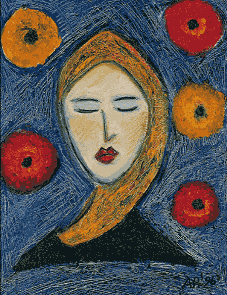May 11, 2010
Whistle-Stop 1 Hour Artweeks Tour (east Oxford), Mon 10 May 2010
Artweeks is brilliant - not just because you can go and poke your nose into people's crazy/beautiful/amazing houses and workspaces, and talk to them about their work too - but because it opens your eyes to just how much industrious creativity is buzzing all around you, all the time.On a whistle-stop 1-hour tour of east Oxford Artweeks shows (they've got their own distinct area map this year - collect one at any of the east Oxford area locations), I managed to get a good look at 6 very different shows in settings ranging from a community garden to a cafe and a church. Stop One was no. 174 in the Artweeks guide: jeweller Lucy Polson's workshop off Warwick Street (behind Iffley Road). This charming higgledy-piggledy building is an Aladdin's cave of shiny treats, with chunky bangles, earrings and more made of copper, silver and semi-precious stones. Prices are artisan level, but then, you get what you pay for: a one-off, totally unique piece, made to suit you (she does commissions) and totally unavailable on the high street. Alongside Lucy's work is some colourful, scarily perfect quilting by local textile artist Janey Forgan (who currently has a piece on display in the V&A). Chances are high that Lucy will be there jewelling in person when you visit.
Stop 2 is just round the corner, at the bottom of Bedford Street (no. 176 in the guide). In a sunny little lean-to conservatory, you'll find Laurence Burrell's soft, misty, vivid blue-green pastels of local river scenes, landscapes and French beaches; watercolours of local city scenes; pencil nude studies and dinky pen-and-ink drawings of Oxford streets (originally created as Christmas cards, but quickly so popular that further reproduction became essential). Ask Laurence about his work - he'll be happy to discuss it.
On again to stop 3: Jane Hope (no. 175) on Argyle Street. I spotted a card by Jane at Laurence's - an eyecatching blue street sky scene with the strung overhead power lines so characteristic of north America. I've got a bit of a thing about the way these spindly structures intersect and interact with the natural and the rest of the built environment, and clearly, so has Jane! In her gorgeous garden studio there are more of these bright, mosaic-like oil paintings and pastels, alongside some
surprisingly easy-on-the-eye east Oxford street portraits (some made to commission) and colourful, attractive fruit and veg still lives. I loved the way the spidery, architectural shapes in Jane's San Francisco power line skylines were echoed by the bare trees in her winter Oxford streetscapes. (www.janehope.co.uk)
Stop 4 was St Alban's Hall, Charles St (no. 180), where Paul Proudman's large-format digital photos of California hang in a fabulously eyecatching way (with an interactive picture trail for children to investigate). I have to say that the picture in the guide (a big red truck) would not have enticed me in, but ignore this! I've seen some unremarkable stuff in St Alban's in the past (sorry!), but this is a stand-out show. Following on neatly from Jane Hope's San Francisco streetscapes, these pieces show a side of California that non-natives might not expect - with a range of nature-based images conveying a more rural perspective (with the odd huge truck, street evangelist or Hell's Angel for variation). There are detailed black and white studies of living cedars, massive hunks of beach driftwood and the grain of the weatherbeaten planks of ruined barns (with a combination of starkness and quirk evoking a kind of hippy Ansell Adams); colour shots of people enjoying beaches and of crazy junk scupltures and a stunningly captured pelican in flight. There are nearly 50 fascinating pictures here so allow yourself some time.
Stop 5 was The Magic Cafe (154, 155), where I expected to see Deidre Ruane's lush-looking ink drawings, but instead found Omega's group exhibit on life with ME. This is pretty heart-rending stuff and, as you might expect, mainly thought-provoking rather than decorative, but it's worth a look if you're passing (and if you don't know anything about ME). There is a gorgeous brightly coloured piece by the loos which uses innovative photographic techniques (by - I think - Luke Bell?) which was the stand out work for me. If anyone knows where Deidre's work has gone - let us know!
My last stop was Barracks Lane Community Garden (no. 145, behind Cowley Rd, signposted via Cumberland Road) where a garden design installation by Kate Jury and Emi Itom is on display in a spacious yurt. These technical print-outs and drawings were a bit dry for my tastes, but if you need a garden designing - a living artwork created, as it were - this would be the place to come to find out more. Helpful people are on hand and the garden itself is a hidden delight. Sign up to the garden's events mailing list while you're there too.
All in all, the standard of work is very high this year, and I was pleasantly surprised at every stop. Not all of these exhibitions are selling exhibitions (see guide for advice), but at those that are, you stand a good chance of being able to pick up a reasonably priced piece of real art by a local person. Most of them close at 6pm but a few open til 7pm - again, see your yellow Artweeks guide. Hop on your bike and see how many you can get to in an hour!
Full info at www.artweeks.org




